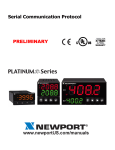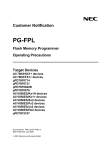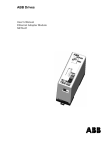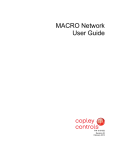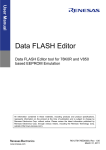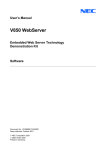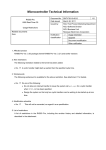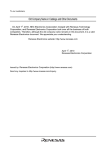Download V850E/PHO2 Traceability Data 32-bit Single
Transcript
User’s Manual V850E/PHO2 Traceability Data 32-bit Single-Chip Microcontroller µPD70F3187 µPD70F3447 µPD76F0053 Document No. U18434EE1V0UM00 Date Published September 2006 © NEC Electronics Corporation 2006 Printed in Germany NOTES FOR CMOS DEVICES 1 VOLTAGE APPLICATION WAVEFORM AT INPUT PIN Waveform distortion due to input noise or a reflected wave may cause malfunction. If the input of the CMOS device stays in the area between VIL (MAX) and VIH (MIN) due to noise, etc., the device may malfunction. Take care to prevent chattering noise from entering the device when the input level is fixed, and also in the transition period when the input level passes through the area between VIL (MAX) and VIH (MIN). 2 HANDLING OF UNUSED INPUT PINS Unconnected CMOS device inputs can be cause of malfunction. If an input pin is unconnected, it is possible that an internal input level may be generated due to noise, etc., causing malfunction. CMOS devices behave differently than Bipolar or NMOS devices. Input levels of CMOS devices must be fixed high or low by using pull-up or pull-down circuitry. Each unused pin should be connected to VDD or GND via a resistor if there is a possibility that it will be an output pin. All handling related to unused pins must be judged separately for each device and according to related specifications governing the device. 3 PRECAUTION AGAINST ESD A strong electric field, when exposed to a MOS device, can cause destruction of the gate oxide and ultimately degrade the device operation. Steps must be taken to stop generation of static electricity as much as possible, and quickly dissipate it when it has occurred. Environmental control must be adequate. When it is dry, a humidifier should be used. It is recommended to avoid using insulators that easily build up static electricity. Semiconductor devices must be stored and transported in an anti-static container, static shielding bag or conductive material. All test and measurement tools including work benches and floors should be grounded. The operator should be grounded using a wrist strap. Semiconductor devices must not be touched with bare hands. Similar precautions need to be taken for PW boards with mounted semiconductor devices. 4 STATUS BEFORE INITIALIZATION Power-on does not necessarily define the initial status of a MOS device. Immediately after the power source is turned ON, devices with reset functions have not yet been initialized. Hence, power-on does not guarantee output pin levels, I/O settings or contents of registers. A device is not initialized until the reset signal is received. A reset operation must be executed immediately after power-on for devices with reset functions. 5 POWER ON/OFF SEQUENCE In the case of a device that uses different power supplies for the internal operation and external interface, as a rule, switch on the external power supply after switching on the internal power supply. When switching the power supply off, as a rule, switch off the external power supply and then the internal power supply. Use of the reverse power on/off sequences may result in the application of an overvoltage to the internal elements of the device, causing malfunction and degradation of internal elements due to the passage of an abnormal current. The correct power on/off sequence must be judged separately for each device and according to related specifications governing the device. 6 INPUT OF SIGNAL DURING POWER OFF STATE Do not input signals or an I/O pull-up power supply while the device is not powered. The current injection that results from input of such a signal or I/O pull-up power supply may cause malfunction and the abnormal current that passes in the device at this time may cause degradation of internal elements. Input of signals during the power off state must be judged separately for each device and according to related specifications governing the device. 2 User’s Manual U18434EE1V0UM00 For further information, please contact: NEC Electronics Corporation 1753, Shimonumabe, Nakahara-ku, Kawasaki, Kanagawa 211-8668, Japan Tel: 044-435-5111 http://www.necel.com/ [America] [Europe] [Asia & Oceania] NEC Electronics America, Inc. 2880 Scott Blvd. Santa Clara, CA 95050-2554, U.S.A. Tel: 408-588-6000 800-366-9782 http://www.am.necel.com/ NEC Electronics (Europe) GmbH Arcadiastrasse 10 40472 Düsseldorf, Germany Tel: 0211-65030 http://www.eu.necel.com/ NEC Electronics (China) Co., Ltd 7th Floor, Quantum Plaza, No. 27 ZhiChunLu Haidian District, Beijing 100083, P.R.China Tel: 010-8235-1155 http://www.cn.necel.com/ Hanover Office Podbielskistrasse 166 B 30177 Hannover Tel: 0 511 33 40 2-0 Munich Office Werner-Eckert-Strasse 9 81829 München Tel: 0 89 92 10 03-0 Stuttgart Office Industriestrasse 3 70565 Stuttgart Tel: 0 711 99 01 0-0 United Kingdom Branch Cygnus House, Sunrise Parkway Linford Wood, Milton Keynes MK14 6NP, U.K. Tel: 01908-691-133 Succursale Française 9, rue Paul Dautier, B.P. 52180 78142 Velizy-Villacoublay Cédex France Tel: 01-3067-5800 Sucursal en España Juan Esplandiu, 15 28007 Madrid, Spain Tel: 091-504-2787 NEC Electronics Shanghai Ltd. Room 2509-2510, Bank of China Tower, 200 Yincheng Road Central, Pudong New Area, Shanghai P.R. China P.C:200120 Tel: 021-5888-5400 http://www.cn.necel.com/ NEC Electronics Hong Kong Ltd. 12/F., Cityplaza 4, 12 Taikoo Wan Road, Hong Kong Tel: 2886-9318 http://www.hk.necel.com/ Seoul Branch 11F., Samik Lavied’or Bldg., 720-2, Yeoksam-Dong, Kangnam-Ku, Seoul, 135-080, Korea Tel: 02-558-3737 NEC Electronics Taiwan Ltd. 7F, No. 363 Fu Shing North Road Taipei, Taiwan, R. O. C. Tel: 02-8175-9600 http://www.tw.necel.com/ NEC Electronics Singapore Pte. Ltd. 238A Thomson Road, #12-08 Novena Square, Singapore 307684 Tel: 6253-8311 http://www.sg.necel.com/ Tyskland Filial Täby Centrum Entrance S (7th floor) 18322 Täby, Sweden Tel: 08 638 72 00 Filiale Italiana Via Fabio Filzi, 25/A 20124 Milano, Italy Tel: 02-667541 Branch The Netherlands Steijgerweg 6 5616 HS Eindhoven The Netherlands Tel: 040 265 40 10 G06.8A All (other) product, brand, or trade names used in this pamphlet are the trademarks or registered trademarks of their respective owners. Product specifications are subject to change without notice. To ensure that you have the latest product data, please contact your local NEC Electronics sales office. User’s Manual U18434EE1V0UM00 3 • The information in this document is current as of September, 2006. The information is subject to change without notice. For actual design-in, refer to the latest publications of NEC Electronics data sheets or data books, etc., for the most up-to-date specifications of NEC Electronics products. Not all products and/or types are available in every country. Please check with an NEC Electronics sales representative for availability and additional information. • No part of this document may be copied or reproduced in any form or by any means without the prior written consent of NEC Electronics. NEC Electronics assumes no responsibility for any errors that may appear in this document. • NEC Electronics does not assume any liability for infringement of patents, copyrights or other intellectual property rights of third parties by or arising from the use of NEC Electronics products listed in this document or any other liability arising from the use of such products. No license, express, implied or otherwise, is granted under any patents, copyrights or other intellectual property rights of NEC Electronics or others. • Descriptions of circuits, software and other related information in this document are provided for illustrative purposes in semiconductor product operation and application examples. The incorporation of these circuits, software and information in the design of a customer's equipment shall be done under the full responsibility of the customer. NEC Electronics assumes no responsibility for any losses incurred by customers or third parties arising from the use of these circuits, software and information. • While NEC Electronics endeavors to enhance the quality, reliability and safety of NEC Electronics products, customers agree and acknowledge that the possibility of defects thereof cannot be eliminated entirely. To minimize risks of damage to property or injury (including death) to persons arising from defects in NEC Electronics products, customers must incorporate sufficient safety measures in their design, such as redundancy, fire-containment and anti-failure features. • NEC Electronics products are classified into the following three quality grades: "Standard", "Special" and "Specific". The "Specific" quality grade applies only to NEC Electronics products developed based on a customerdesignated "quality assurance program" for a specific application. The recommended applications of an NEC Electronics product depend on its quality grade, as indicated below. Customers must check the quality grade of each NEC Electronics product before using it in a particular application. "Standard": Computers, office equipment, communications equipment, test and measurement equipment, audio and visual equipment, home electronic appliances, machine tools, personal electronic equipment and industrial robots. "Special": Transportation equipment (automobiles, trains, ships, etc.), traffic control systems, anti-disaster systems, anti-crime systems, safety equipment and medical equipment (not specifically designed for life support). "Specific": Aircraft, aerospace equipment, submersible repeaters, nuclear reactor control systems, life support systems and medical equipment for life support, etc. The quality grade of NEC Electronics products is "Standard" unless otherwise expressly specified in NEC Electronics data sheets or data books, etc. If customers wish to use NEC Electronics products in applications not intended by NEC Electronics, they must contact an NEC Electronics sales representative in advance to determine NEC Electronics' willingness to support a given application. (Note) (1) "NEC Electronics" as used in this statement means NEC Electronics Corporation and also includes its majority-owned subsidiaries. (2) "NEC Electronics products" means any product developed or manufactured by or for NEC Electronics (as defined above). M8E 02. 11-1 4 User’s Manual U18434EE1V0UM00 Table of Contents Chapter 1 1.1 Chapter 2 2.1 Overview . . . . . . . . . . . . . . . . . . . . . . . . . . . . . . . . . . . . . . . . . . . . . . . . . . . . . . 9 Naming Conventions . . . . . . . . . . . . . . . . . . . . . . . . . . . . . . . . . . . . . . . . . . . . . . . . . . . . 9 Traceability Data. . . . . . . . . . . . . . . . . . . . . . . . . . . . . . . . . . . . . . . . . . . . . . . 10 Description of the Traceability Data. . . . . . . . . . . . . . . . . . . . . . . . . . . . . . . . . . . . . . . 11 2.1.1 X-Index . . . . . . . . . . . . . . . . . . . . . . . . . . . . . . . . . . . . . . . . . . . . . . . . . . . . . . . . 11 2.1.2 Y-Index . . . . . . . . . . . . . . . . . . . . . . . . . . . . . . . . . . . . . . . . . . . . . . . . . . . . . . . . 11 2.1.3 Wafer No. . . . . . . . . . . . . . . . . . . . . . . . . . . . . . . . . . . . . . . . . . . . . . . . . . . . . . . 11 2.1.4 Pass/Fail . . . . . . . . . . . . . . . . . . . . . . . . . . . . . . . . . . . . . . . . . . . . . . . . . . . . . . . 11 2.1.5 Diffusion Lot No. . . . . . . . . . . . . . . . . . . . . . . . . . . . . . . . . . . . . . . . . . . . . . . . . . 11 2.1.6 Line number, Plant number . . . . . . . . . . . . . . . . . . . . . . . . . . . . . . . . . . . . . . . . 11 2.1.7 Product version. . . . . . . . . . . . . . . . . . . . . . . . . . . . . . . . . . . . . . . . . . . . . . . . . . 11 2.1.8 Alphabet code. . . . . . . . . . . . . . . . . . . . . . . . . . . . . . . . . . . . . . . . . . . . . . . . . . . 11 2.1.9 Standard Custom marker . . . . . . . . . . . . . . . . . . . . . . . . . . . . . . . . . . . . . . . . . . 12 2.1.10 Product code (4 last digits) . . . . . . . . . . . . . . . . . . . . . . . . . . . . . . . . . . . . . . . . . 12 User’s Manual U18434EE1V0UM00 5 6 User’s Manual U18434EE1V0UM00 Introduction Readers This User’s Manual is intended for users who want to understand the functionality of the V850E/PHO2 Traceability Data for devices µPD70F3187, µPD70F3447 and µPD76F0053 of the V850 core family. Purpose This User’s Manual explains the background and handling of the V850E/PHO2 Traceability Data for devices µPD70F3187, µPD70F3447 and µPD76F0053 of the V850 core family. Organization This User’s Manual contains the major sections: • Legend Description of the traceability data Symbols and notation are used as follows: Weight in data notation : Left is high-order column, right is low order column Active low notation : xxx (pin or signal name is over-scored) or /xxx (slash before signal name) Memory map address: : High order at high stage and low order at low stage Note : Explanation of (Note) in the text Caution : Information requiring particular attention Remark : Supplementary explanation to the text Numeric notation : Binary... XXXX or XXXB Decimal... XXXX Hexadecimal... XXXXH or 0x XXXX Prefixes representing powers of 2 (address space, memory capacity) K (kilo): 210 = 1024 M (mega): 220 = 10242 = 1,048,576 G (giga): 230 = 10243 = 1,073,741,824 User’s Manual U18434EE1V0UM00 7 8 User’s Manual U18434EE1V0UM00 Chapter 1 Overview This Users Manual describes the format of traceability data to be used to identify and obtain device specific production data. This specification is applicable to V850E/PHO2 (µPD76F0053, µPD70F3187, µPD70F 3447). 1.1 Naming Conventions Certain terms, required for the description of the traceability data are long and too complicated for good readability of the document. Therefore, special names and abbreviations will be used in the course of this document to improve the readability. Extra Area Extra Area is a separate area of the code flash that is used to store special parameter such as traceability data, trimming data etc. The access to the extra area is not granted by the application. Only a special library or the device internal firmware can read such area. User’s Manual U18434EE1V0UM00 9 Chapter 2 Traceability Data The traceability data are stored at fixed addresses in the extra area of the device’s flash memory. Figure 2-1: bit31 bit30 bit29 bit28 bit27 bit26 bit25 bit24 bit23 bit22 bit21 bit20 bit19 bit18 bit17 bit16 Product Code (4 last digits) bit15 bit14 bit13 bit12 bit11 bit10 bit9 1 Alphabet Code 0x432 0x430 V850E/PHO2 Traceability Data Standard/Custom bit31 bit8 bit7 bit6 bit5 bit4 Product Version bit3 bit2 bit1 bit0 0x422 bit30 bit29 bit28 bit27 bit26 bit25 bit24 bit23 bit22 bit21 bit20 bit19 bit18 bit17 bit16 Plant Code Line No. Diffusion Lot No.(Year.)Diffusion Lot No.(Month.) 0x420 bit15 bit14 bit13 bit12 bit11 bit10 bit9 bit8 bit7 bit6 bit5 bit4 bit3 bit2 bit1 bit0 Diffusion Lot No.(4th dig.) Diffusion Lot No.(3rd dig.Diffusion Lot No.(2nd dig.Diffusion Lot No.(1st dig. 0x41A bit31 bit30 bit29 bit28 bit27 bit26 bit25 bit24 bit23 bit22 bit21 bit20 bit19 bit18 bit17 bit16 Wafer No. Pass/Fail bit15 0x418 10 bit14 bit13 bit12 bit11 bit10 bit9 Y-Index bit8 bit7 bit6 bit5 User’s Manual U18434EE1V0UM00 bit4 bit3 X-Index bit2 bit1 bit0 Chapter 2 Traceability Data 2.1 Description of the Traceability Data 2.1.1 X-Index The value consist of an 8-bit value that locates the X axis of the location of the die on the wafer. 2.1.2 Y-Index The value consist of an 8-bit value that locates the Y axis of the location of the die on the wafer. 2.1.3 Wafer No. The value gives the wafer number as 6-bit value. 2.1.4 Pass/Fail A single bit indicates whether the specific die passed or failed the production. Pass is 1b, fail is 0b. 2.1.5 Diffusion Lot No. The diffusion lot number consists of 6 groups of four bits each. The lot number year and month consist of 4bits each having a range of 0...Fh each. Example 09/2006 will result in 0609h. 2.1.6 Line number, Plant number Give the diffusion line number of the specified production line and plant. The diffusion line for PHO2 will be 1111b or Fh. The plant number will be 1111b or Fh for NMS Kyushu plant. 2.1.7 Product version The 12-bit wide value indicates the device version of the dedicated product. The value is divided in three groups of four bits each. E.g. V2.1.0 will be 0010 0001 0000b or 210h. V2.2.0 will be 0010 0010 0000b or 220h. 2.1.8 Alphabet code Defines the device suffix, e.g. V2.2 µPD76F0053A is 01b. Value Definition 00b non 01b A 10b B 11b H User’s Manual U18434EE1V0UM00 11 Chapter 2 Traceability Data 2.1.9 Standard Custom marker The single bit indicates if it is a customised or standard product. Customised product will have a 0b, while standard products will have a 1b. 2.1.10 Product code (4 last digits) The value is divided into four groups of three bits each. E.g. uPD76F0053 will be 0000 0000 0101 0011b or 0053h. uPD70F3187 will be 0011 0001 1000 0111b or 3187h. 12 User’s Manual U18434EE1V0UM00













